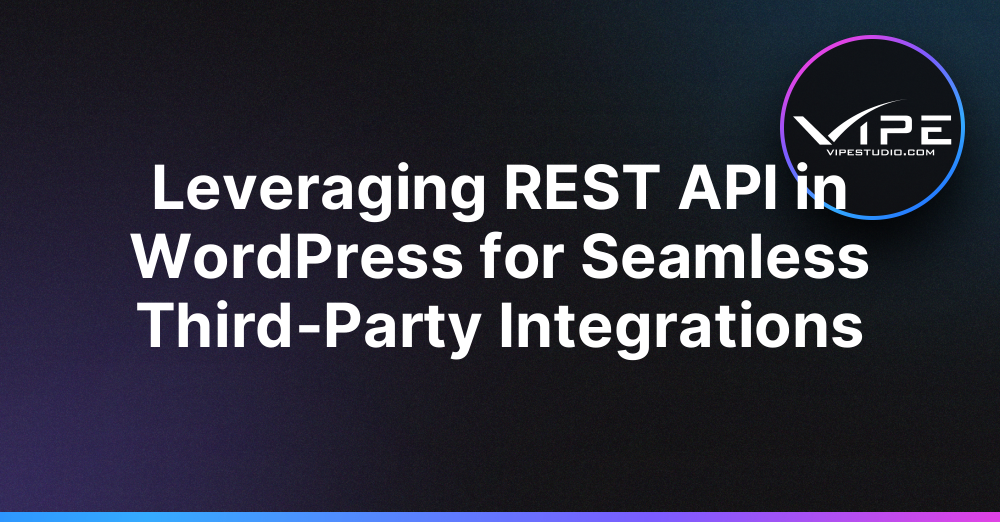12.05.2025
WordPress Development
Leveraging REST API in WordPress for Seamless Third-Party Integrations
READING TIME: MIN
Table of Content
In today’s digital ecosystem, seamless integration between platforms is critical to business agility. Enterprises often rely on multiple systems—CRMs, ERPs, marketing tools, and analytics platforms—that need to communicate with their websites. WordPress, while traditionally seen as a content management system, has evolved into a flexible application platform thanks to the REST API. For enterprise projects, this opens a gateway to powerful and scalable integrations.
Why REST API Has Become a Pillar of Modern WordPress Development
The REST API provides a standardized way for external applications to interact with WordPress content and functionality. Through HTTP requests, developers can create, read, update, and delete data within a WordPress site—bypassing the traditional front-end interface. This decouples the CMS from its presentation layer, empowering developers to use WordPress as a headless back-end or integrate it deeply with third-party platforms.
Connecting WordPress to Enterprise Software: CRMs, ERPs, and Beyond
Enterprises often require their website to work in tandem with robust business tools like Salesforce, HubSpot, SAP, or Microsoft Dynamics. With the REST API, developers can synchronize form submissions, user data, or content updates directly with these systems in real time. This allows for automation of lead generation, customer management, and internal workflows—all without manually exporting and importing data between platforms.
For example, using WordPress forms to capture user information and pushing it automatically to a CRM is a common use case. This ensures that marketing and sales teams always work with up-to-date data.
Building Custom Applications with WordPress as the Data Backbone
With REST API capabilities, WordPress can serve as the content engine for custom front-end applications—whether mobile apps, single-page applications (SPAs), or IoT devices. By exposing endpoints, you can retrieve structured content in JSON format and present it in a completely custom user interface. This is particularly valuable for companies seeking performance-optimized user experiences beyond the limitations of classic WordPress themes.
Many enterprises are now pairing WordPress with frameworks like Next.js or Nuxt to build decoupled applications that maintain fast performance and high scalability. At Vipe Studio, we specialize in building headless WordPress architectures with seamless front-end frameworks using REST or GraphQL APIs.
Security and Authentication Considerations for REST API Projects
When exposing or consuming data via API, security must be a top concern—especially for enterprise websites that handle sensitive information. WordPress REST API supports authentication methods like OAuth, application passwords, and cookie-based authentication. Implementing role-based permissions ensures that only authorized systems and users can access specific endpoints.
Enterprises often implement custom authentication layers, token rotation strategies, and encrypted communication protocols to ensure data integrity across API calls.
Enhancing Internal Workflows Through API-Driven Automation
Beyond public-facing integrations, the REST API can be leveraged to streamline internal processes. Companies can automate content creation pipelines, sync product catalogs from internal databases, or generate reports by querying analytics data through custom endpoints. This minimizes manual tasks, increases efficiency, and provides a more connected digital infrastructure.
Version Control and Scalability of API Architectures
To ensure long-term scalability and compatibility, enterprise developers should implement version control for custom APIs. This allows the back-end system to evolve without breaking existing front-end or third-party integrations. Versioning, combined with thorough documentation and testing, ensures maintainable and extensible solutions that grow with your organization’s needs.
At Vipe Studio, we help enterprises structure their REST API architecture in a modular and future-proof way—laying the groundwork for iterative improvements without disrupting operations.
When to Choose REST API Over Traditional WordPress Functionality
While the REST API is powerful, it’s not always necessary for every project. For websites that don’t require decoupling or external integrations, traditional WordPress themes and plugins may be sufficient. However, when data needs to flow between multiple platforms, or when user interfaces need to be tailored outside WordPress’s templating system, the API becomes a vital tool.
Conclusion: WordPress REST API as a Foundation for Digital Ecosystems
For modern enterprises, the website is no longer a siloed channel—it’s a core part of a larger digital strategy. The WordPress REST API transforms the CMS into a dynamic, interconnected platform that supports automation, integration, and innovation. Whether you’re connecting your site to internal systems or building entirely new digital experiences, REST API provides the flexibility and power to bring your vision to life.
If you’re ready to expand your enterprise website’s capabilities, contact Vipe Studio to learn how we can implement secure and scalable API solutions tailored to your business.
More on The Topic
- WordPress Performance Debt Nobody Talks About
- The Admin UX That Shapes Decisions
- Scaling WordPress Without Losing Culture
- WordPress 6.9 “Gene”: What This Release Really Changes
- Managing Gutenberg Chaos at Scale
The content of this website is copyrighted and protected by Creative Commons 4.0.



